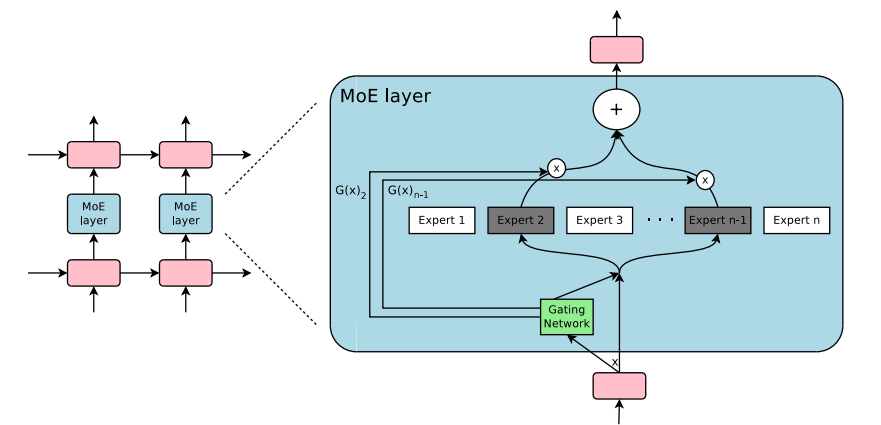What is Mixture of Experts (MoE)? The Secret Behind Efficient AI Models
FREE**1. Introduction: The Dilemma of AI Scaling**
Imagine an AI model as a massive brain, processing language with human-like precision. But there’s a catch—every time we scale these models for better accuracy, we also multiply their computational cost. What if we could have both power and efficiency?
🚀 Enter Mixture of Experts (MoE)—a game-changing architecture that activates only the necessary parts of a model, reducing computational cost without sacrificing intelligence.
Traditional deep learning models rely on dense architectures, where every neuron works on every input. This brute-force approach is powerful but unsustainable for scaling large language models (LLMs) like GPT-4. MoE changes the game by making AI smarter, not just bigger.
**2. The Core Architecture of Mixture of Experts (MoE)**
**How MoE Works: A Smarter Way to Process Information**
Unlike standard models that process every input with all their neurons, MoE activates only a subset of its neural networks—called experts—for each input.
🔹 Key Component: The Gating Network
Instead of treating all data equally, MoE employs a gating network to decide which few experts should process each token of input.
- Think of it like a university: You don’t send every student to every professor. Instead, a guidance system directs students to the most relevant subject-matter experts.
🔹 Mathematical Formulation
At its core, MoE can be expressed as:
y = Σᵢⁱᴺ G(x)ᵢ Eᵢ(x)
where:
- ( G(x) ) is the gating function, which assigns input to the best expert(s).
- ( E_i(x) ) represents the expert networks that handle the computation.
- The sum ensures that multiple experts contribute proportionally to the output.
 Image taken from Hugging Face
Image taken from Hugging Face
**Comparison to Traditional Dense Models**
| Feature | Dense Models | Mixture of Experts |
|---|---|---|
| Computational Load | All neurons process every input | Only a few experts activate per input |
| Scalability | High cost per scale | Efficient scaling with expert selection |
| Specialization | One-size-fits-all model | Different experts specialize in different tasks |
By allowing specialization, MoE improves performance while reducing computation costs, making it ideal for large-scale AI models.
**3. Advantages and Trade-offs of MoE**
✅ **Why MoE is a Game-Changer**
🔹 Computational Efficiency – Instead of overloading the entire model, MoE activates only relevant experts, reducing FLOPs (Floating Point Operations) per inference.
🔹 Better Scalability – Unlike traditional LLMs, which become exponentially more expensive to scale, MoE allows for larger models without increasing computational cost at the same rate.
🔹 Higher Model Capacity – More parameters can be added without inflating inference costs, meaning AI models can learn more without being computationally bloated.
⚠️ **Challenges in MoE Models**
❌ Load Balancing Issues – Some experts get used more frequently than others, leading to bottlenecks. If one expert is overwhelmed while others are underutilized, efficiency suffers.
❌ Training Instability – The gating function can favor certain experts disproportionately, causing others to collapse or become redundant.
❌ Communication Overhead – In multi-GPU setups, transferring data between different experts increases latency, requiring advanced parallelization techniques.
Despite these challenges, MoE has proven to be the most promising approach for efficiently scaling AI.
**4. Real-World MoE Implementations in LLMs**
Here’s how leading AI models are leveraging MoE to revolutionize efficiency:
| Model | Number of Experts | Experts Activated | Key Features |
|---|---|---|---|
| DeepSeek-MoE | 64 | 2 | Open-source, efficient routing |
| Switch Transformer (Google) | 32 | 1 | First large-scale MoE model |
| GLaM (Google) | 64 | 2 | High accuracy, lower training cost |
| Mixtral (Mistral AI) | 8 | 2 | Stability & fast inference |
| AlexaTM 20B (Amazon) | 16 | 2 | Optimized for real-world NLP |
**🔍 DeepSeek-MoE: A Closer Look**
Among modern MoE models, DeepSeek-MoE stands out as one of the most efficient open-source implementations.
- Uses 64 experts, but activates only 2 per token → Lower computational cost, high efficiency.
- Designed to minimize expert imbalance, solving a critical weakness in earlier MoE models.
- Competes with dense models like GPT-4, but at significantly lower training cost.
**📌 Real-World Applications of MoE**
✅ High-performance NLP → Faster, cheaper large-scale text generation.
✅ Efficient deployment → Reduces inference costs for production AI applications.
✅ Custom AI Solutions → Fine-tuned for domain-specific tasks like legal, medical, or financial AI.
**5. The Future of MoE in AI Research & Development**
🔮 Next-Gen MoE Innovations:
🚀 Hierarchical MoE: Multi-layered expert selection for deeper specialization.
🚀 Dynamic Expert Pruning: AI models can drop unused experts automatically to improve efficiency.
🚀 Hybrid MoE & Sparse Models: Combining MoE with retrieval-augmented generation (RAG) to improve factual accuracy in LLMs.
**🌎 MoE Will Shape the Future of AI Scaling**
With computational costs becoming the biggest bottleneck for scaling AI, Mixture of Experts is not just an option—it’s a necessity. Companies and researchers are already shifting toward MoE-powered architectures to balance cost, efficiency, and intelligence.
**6. Conclusion & Call to Action**
Mixture of Experts is revolutionizing AI, making models smarter, faster, and more cost-efficient.
If you’re an AI researcher, explore DeepSeek-MoE’s open-source implementation. If you’re a developer, try implementing MoE layers in PyTorch or TensorFlow to experience the benefits firsthand.







